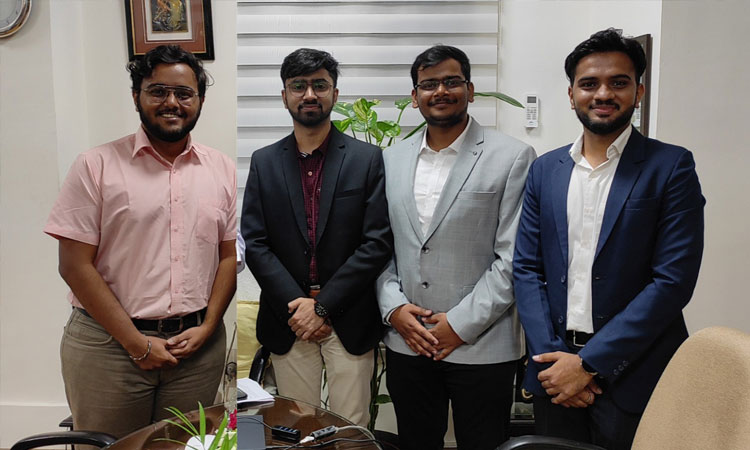India is poised for a transformative leap in transportation, and the trailblazers behind that leap are the founders of Quintrans—Prasanna Kadambi, Kartik Kulkarni, and CEO Pranay Luniya. Their mission: to bring Hyperloop technology to India and redefine intercity travel starting with the Mumbai–Pune corridor. In this exclusive interview with The Machining World, Pranay Luniya shares how Quintrans is turning a futuristic vision into a tangible reality, setting the stage for a new era of high-speed, sustainable mobility.
Q: What inspired Quintrans to pursue Hyperloop technology in the first place?
A: During our university years, we were fascinated by maglev systems and the revolutionary concept of the Hyperloop. The idea of traveling between Mumbai and Pune in under 30 minutes felt like magic. We were driven to be the ones who could make that magic real. The Mumbai–Pune corridor, with over 2 lakh daily commuters, was an obvious choice to pilot such innovation.
Q: What makes the Mumbai–Pune corridor an ideal choice for launching the Hyperloop?
A: This corridor is not just one of India’s busiest but ranks among the top in the world. The demand for faster, more efficient travel between these two urban hubs is immense. It presents both a challenge and an opportunity—exactly what we needed to showcase the viability and impact of Hyperloop technology.
Q: What major technological challenges does Hyperloop present, and how is Quintrans tackling them?
A: Hyperloop is often dubbed the fifth mode of transportation—and rightly so. It’s a completely new system, not just a train in a tube. We’re developing critical technologies in-house, such as advanced motors, magnetic levitation systems, pod chassis, HVAC systems, and high-efficiency controllers. It’s a convergence of traditional mechanical and civil engineering with cutting-edge innovation.
Q: How has the government supported your mission so far?
A: We’ve received substantial encouragement from the Indian government, including funding and research support. Since Hyperloop has not yet been successfully commercialized anywhere in the world, India sees this as a unique opportunity to lead globally. We’re working closely with the Ministry of Railways and other public institutions to make this happen.
Q: What’s the current timeline for building the Hyperloop in India, and when can we expect to see it operational?
A: It’s a dynamic timeline, but the Ministry of Railways has proposed a 10-kilometre test track for both cargo and passengers, which should be completed before 2030. Long-term, the goal is to establish at least five Hyperloop corridors across India by 2047, in line with India’s centennial of independence.
Q: How will Hyperloop change the travel experience between Mumbai and Pune?
A: It will be nothing short of revolutionary. You’ll travel faster than a plane but with the convenience of a metro. Pods will run every 15 minutes, eliminating the need for advance bookings. Tickets will cost around Rs 1,500, offering not just speed but affordability. The entire commute will take just 25 minutes, making daily intercity travel more viable than ever.
Q: With rising environmental concerns, how sustainable is the Hyperloop system?
A: Sustainability is at the core of what we’re building. Hyperloop will run on 100% electricity, and our goal is to source this entirely from renewable energy, primarily solar power. Because it operates in an enclosed vacuum tube, it also produces zero noise pollution and no greenhouse gas emissions. It’s arguably the greenest transport system ever envisioned.
Q: What are the safety protocols in place for this new and emerging technology?
A: Safety is non-negotiable. We’ve involved international certification agencies right from the early design phase to ensure that safety standards are embedded in the core of the system. Our pods and tubes are being designed with multiple fail-safes, emergency protocols, and structural redundancies to make it completely passenger-ready.
Q: Beyond Mumbai and Pune, are there other corridors that could benefit from Hyperloop in India?
A: Absolutely. India is the perfect geography for Hyperloop because of its many city clusters that are too close for air travel and too far for efficient road or rail transit. Corridors like Bengaluru–Chennai, Delhi–Chandigarh, Ahmedabad–Jaipur, Hyderabad–Amravati, and Lucknow–Kanpur are all highly promising routes. We’re designing the system to scale across multiple geographies.
Q: What kinds of engineering expertise are involved in building a Hyperloop system from scratch?
A: Hyperloop development requires a blend of mechanical, electrical, electronics, civil, and even aerospace engineering. We’re designing motors, magnetic propulsion systems, high-speed chassis, power converters, and control systems. On the civil side, building elevated tubes, stations, and support structures demands advanced construction techniques and precise project management.
Q: How does Quintrans envision its role in the global Hyperloop race?
A: We see Quintrans not just as a participant, but as a global leader in Hyperloop development. Most countries are still experimenting, while we are building. Our integrated approach—developing everything from hardware to infrastructure within India—puts us in a unique position to export both technology and expertise in the near future.
Q: Finally, what drives you and your team at Quintrans to pursue something so bold and complex?
A: It’s the vision of a smarter, faster, and cleaner India. Our country needs transformative solutions, not incremental fixes. Hyperloop is one of those rare ideas that can fundamentally reshape how we think about travel. We’re not just building a transport system—we’re building the future of mobility.
With passion, precision, and a commitment to innovation, Quintrans is bringing India closer to a Hyperloop-powered future. The challenges may be immense, but so is the ambition. As the world watches, this homegrown startup is proving that when the vision is bold and the execution relentless, even the most futuristic ideas can become real—and redefine a nation’s journey forward.


